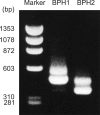Differential alternative splicing of human transglutaminase 4 in benign prostate hyperplasia and prostate cancer
- PMID: 20177144
- PMCID: PMC2859330
- DOI: 10.3858/emm.2010.42.4.031
Differential alternative splicing of human transglutaminase 4 in benign prostate hyperplasia and prostate cancer
Abstract
Transglutaminase 4 is a member of enzyme family that catalyzes calcium-dependent posttranslational modification of proteins. Although transglutaminase 4 has been shown to have prostate-restricted expression pattern, little is known about the biological function of transglutaminase 4 in human. To gain insight into its role in prostate, we analyzed the expression status of human transglutaminase 4 in benign prostate hyperplasia (BPH) and prostate cancer (PCa). Unexpectedly, RT-PCR and nucleotide sequence analysis showed four alternative splicing variants of transglutaminase 4: transglutaminase 4-L, -M (-M1 and -M2) and -S. The difference between transglutaminase 4-M1 and -M2 is attributed to splicing sites, but not nucleotide size. The deduced amino acid sequences showed that transglutaminase 4-L, -M1 and -M2 have correct open reading frames, whereas transglutaminase 4-S has a truncated reading frame. RT-PCR analysis of clinical samples revealed that transglutaminase 4-M and -S were detected in all tested prostate tissue (80 BPH and 48 PCa). Interestingly, transglutaminase 4-L was found in 56% of BPH (45 out of 80) and only in 15% of PCa (7 out of 48). However, transglutaminase 4-L expression did not correlate with serum prostate-specific antigen (PSA) level, prostate volumes or PSA densities. These results will provide a clue to future investigation aiming at delineating physiological and pathological roles of human transglutaminase 4.
Figures






Similar articles
-
Search for Novel Diagnostic Biomarkers of Prostate Inflammation-Related Disorders: Role of Transglutaminase Isoforms as Potential Candidates.Mediators Inflamm. 2019 Jul 9;2019:7894017. doi: 10.1155/2019/7894017. eCollection 2019. Mediators Inflamm. 2019. PMID: 31360119 Free PMC article. Review.
-
Loss of tissue transglutaminase as a biomarker for prostate adenocarcinoma.Cancer. 2000 Jul 15;89(2):412-23. doi: 10.1002/1097-0142(20000715)89:2<412::aid-cncr29>3.0.co;2-o. Cancer. 2000. PMID: 10918174
-
Expression of transglutaminase-2 isoforms in normal human tissues and cancer cell lines: dysregulation of alternative splicing in cancer.Amino Acids. 2013 Jan;44(1):33-44. doi: 10.1007/s00726-011-1127-4. Epub 2011 Nov 17. Amino Acids. 2013. PMID: 22089883
-
Expression of human prostatic acid phosphatase and prostate specific antigen genes in neoplastic and benign tissues.Biochem Mol Biol Int. 1994 Jun;33(3):567-74. Biochem Mol Biol Int. 1994. PMID: 7524903
-
[Molecular forms of prostate-specific antigen and their clinical significance].Urologe A. 1995 Jul;34(4):275-82. Urologe A. 1995. PMID: 7545841 Review. German.
Cited by
-
Characterization of tissue-specific biomarkers with the expression of circRNAs in forensically relevant body fluids.Int J Legal Med. 2019 Sep;133(5):1321-1331. doi: 10.1007/s00414-019-02027-y. Epub 2019 Feb 27. Int J Legal Med. 2019. PMID: 30810820
-
Prostate transglutaminase (TGase-4) antagonizes the anti-tumour action of MDA-7/IL-24 in prostate cancer.J Transl Med. 2011 Apr 28;9:49. doi: 10.1186/1479-5876-9-49. J Transl Med. 2011. PMID: 21524313 Free PMC article.
-
Vena cava and aortic smooth muscle cells express transglutaminases 1 and 4 in addition to transglutaminase 2.Am J Physiol Heart Circ Physiol. 2012 Apr 1;302(7):H1355-66. doi: 10.1152/ajpheart.00918.2011. Epub 2012 Feb 3. Am J Physiol Heart Circ Physiol. 2012. PMID: 22307675 Free PMC article.
-
Transglutaminase 6: a protein associated with central nervous system development and motor function.Amino Acids. 2013 Jan;44(1):161-77. doi: 10.1007/s00726-011-1091-z. Epub 2011 Oct 8. Amino Acids. 2013. PMID: 21984379 Free PMC article.
-
Mating Changes Sexually Dimorphic Gene Expression in the Seed Beetle Callosobruchus maculatus.Genome Biol Evol. 2017 Mar 1;9(3):677-699. doi: 10.1093/gbe/evx029. Genome Biol Evol. 2017. PMID: 28391318 Free PMC article.
References
-
- An G, Meka CS, Bright SP, Veltri RW. Human prostate-specific transglutaminase gene: promoter cloning, tissue-specific expression, and down-regulation in metastatic prostate cancer. Urology. 1999;54:1105–1111. - PubMed
-
- Blencowe BJ. Alternative splicing: new insights from global analyses. Cell. 2006;126:37–47. - PubMed
-
- Carstens RP, Eaton JV, Krigman HR, Walther PJ, Garcia-Blanco MA. Alternative splicing of fibroblast growth factor receptor 2 (FGF-R2) in human prostate cancer. Oncogene. 1997;15:3059–3065. - PubMed
-
- Chomczynski P, Sacchi N. Single-step method of RNA isolation by acid guanidinium thiocyanate-phenol-chloroform extraction. Anal Biochem. 1987;162:156–159. - PubMed
-
- Cukierski MA, Sina JL, Prahalada S, Robertson RT. Effects of seminal vesicle and coagulating gland ablation on fertility in rats. Reprod Toxicol. 1991;5:347–352. - PubMed
Publication types
MeSH terms
Substances
LinkOut - more resources
Full Text Sources
Medical
Research Materials
Miscellaneous
